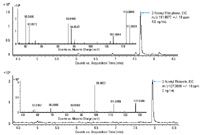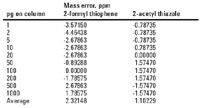Analysis of Medium Volatility Sulfur Compounds in Coffee Using Agilent GC/Q-TOF
The resolution, sensitivity, and mass accuracy of the Agilent 7200 GC/Q-TOF system provide rapid, simple, and reliable analysis of trace levels of sulfur compounds in coffee.
INTRODUCTION
The resolution, sensitivity, and mass accuracy of the Agilent 7200 GC/Q-TOF system provide rapid, simple, and reliable analysis of trace levels of sulfur compounds in coffee.
Volatile sulfur, containing compounds present in coffee, plays an important role in aroma and flavor. Characterization of desirable coffee aroma can be a challenging task, since many of these compounds are present in trace amounts. Identification and quantitation of sulfur compounds present in complex food matrices at trace levels (low ng/mL in matrix) often requires time-consuming sample preparation as well as elaborate techniques with high separation power, such as 2D GC combined with mass spectrometry. Using the resolution, sensitivity, and speed of an Agilent GC/Q-TOF system, consistent product quality can be monitored with minimal sample preparation and a standard 1D GC method.

Figure 1. TIC of coffee extract (not spiked with sulfur compound standards), illustrating the complexity ot the matrix
For the GC/Q-TOF method, a simple liquid-liquid extraction is adequate sample preparation before the analysis of medium volatility sulfur compounds in coffee. High-resolution mass spectra with low mass error help to resolve compounds of interest from severe matrix interferences. The 7200 GC/Q-TOF provides low pg method detection limits with less than 5 ppm error in mass accuracy. Linearity up to three orders of magnitude in matrix is achieved with a correlation coefficient > 0.995. Standard addition method was successfully applied for determination of 2-formyl thiophene and 2-acetyl thiazole concentrations at ng/mL levels naturally occurring in coffee extract.

Figure 2. EIC and mass spectra of 2-formyl thiophene and 2-acetyl thiazone at their natural levels extracted from a coffee matrix
In summary, an Agilent 7200 GC/Q-TOF system is able to provide trace-level compound profiling in complex food matrices, without the need for complex and tedious sample preparation and separation methods.

Table 1. Mass error for 2-formyl thiophene and 2-acetyl thiazole measured in spiked coffee extract
The method was developed by Nobuo Ochiai and Kikuo Sasamoto of Gerstel K.K. and Ryo Ogasawara and Sofia Aronova of Agilent Technologies, Inc.
KEY BENEFITS
- The Agilent 7200 GC/Q-TOF enables a fast and simple method for routine analysis of sulfur compounds in complex food matrices.
- High sensitivity allows qualitative and quantitative analysis of volatile sulfur compounds in coffee down to 1 pg on column.
- The resolution and mass accuracy of the Agilent 7200 Series GC/Q-TOF provide sufficient selectivity for analyte quantitation in complex food matrices.
- Linearity up to three orders of magnitude facilitates quantitation over a large concentration range.
Agilent shall not be liable for errors contained herein or for incidental or consequential damages in connection with the furnishing, performance, or use of this material. Information, descriptions, and specifications in this publication are subject to change without notice.
Study Examines Impact of Zwitterionic Liquid Structures on Volatile Carboxylic Acid Separation in GC
March 28th 2025Iowa State University researchers evaluated imidazolium-based ZILs with sulfonate and triflimide anions to understand the influence of ZILs’ chemical structures on polar analyte separation.
Quantifying Microplastics in Meconium Samples Using Pyrolysis–GC-MS
March 26th 2025Using pyrolysis-gas chromatography and mass spectrometry, scientists from Fudan University and the Putuo District Center for Disease Control and Prevention detected and quantified microplastics in newborn stool samples.






